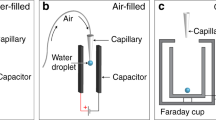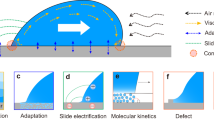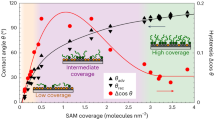Abstract
THE interfacial tension between mercury and water is generally accepted, on the basis of capillary rise and drop weight measurements, as being about 375 dynes/cm, at 20° C.1, but using a sessile drop method, Burdon and Oliphant2 have obtained a value of 427 dynes/cm. The suggestion that the discrepancy might be due to the invalidity of certain assumptions made in the calculations from capillary rise and drop weight observations was disposed of by Brown3, who obtained a value of 374.2 dynes/cm, at 25° C. by the sessile drop method.
This is a preview of subscription content, access via your institution
Access options
Subscribe to this journal
Receive 51 print issues and online access
$199.00 per year
only $3.90 per issue
Buy this article
- Purchase on Springer Link
- Instant access to full article PDF
Prices may be subject to local taxes which are calculated during checkout
Similar content being viewed by others
References
Landolt-Börnstein (fifth edition), 1, 243, quotes four determinations: 375, 372.4 and 370.1 at 20° C., 374 at 0° C. Bartell, Case and Brown, J. Amer. Chem. Soc., 55, 2419 (1933). Glidden, J. Amer. Chem. Soc., 57, 236 (1935).
Burdon and Oliphant, Trans. Farad. Soc., 23, 205 (1927).
Brown, J. Amer. Chem. Soc., 56, 2564 (1934).
Gouy, Ann. Phys., (9), 6, 5 (1916).
Author information
Authors and Affiliations
Rights and permissions
About this article
Cite this article
HENRY, D., JACKSON, J. Interfacial Tension between Mercury and Water. Nature 142, 616–617 (1938). https://doi.org/10.1038/142616b0
Issue Date:
DOI: https://doi.org/10.1038/142616b0
Comments
By submitting a comment you agree to abide by our Terms and Community Guidelines. If you find something abusive or that does not comply with our terms or guidelines please flag it as inappropriate.



